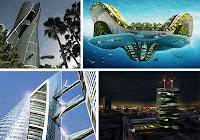Discovery and Developing Green Technologies

Green technologies development is a myth? or a sustaintable project development
What is Green Technology?
GREEN TECHNOLOGY
DEFINITIONThe term “technology” refers to the application of knowledge for practical purposes.
The field of “green technology” encompasses a continuously evolving group of methods and materials, from techniques for generating energy to non-toxic cleaning products.
The present expectation is that this field will bring innovation and changes in daily life of similar magnitude to the “information technology” explosion over the last two decades. In these early stages, it is impossible to predict what “green technology” may eventually encompass.
- Sustainability - meeting the needs of society in ways that can continue indefinitely into the future without damaging or depleting natural resources. In short, meeting present needs without compromising the ability of future generations to meet their own needs.
- “Cradle to cradle” design - ending the “cradle to grave” cycle of manufactured products, by creating products that can be fully reclaimed or re-used.
- Source reduction - reducing waste and pollution by changing patterns of production and consumption.
- Innovation - developing alternatives to technologies - whether fossil fuel or chemical intensive agriculture - that have been demonstrated to damage health and the environment.
- Viability - creating a center of economic activity around technologies and products that benefit the environment, speeding their implementation and creating new careers that truly protect the planet.
GREEN TECHNOLOGY SUBJECT AREAS
- Energy - Perhaps the most urgent issue for green technology, this includes the development of alternative fuels, new means of generating energy and energy
- Algae- to-Fuel Research Enjoys Resurgence at NREL - NREL maintains a repository of hundreds of strains of algae that could be used to make biofuels. The strains must be grown and maintained under strict temperature and light conditions. Passenger jets cruise at 35,000 feet without a hiccup. Catfish farmers lease ponds to biofuels entrepreneurs. Venture capitalists sink $1 billion into green crude.BD Medical and Millipore Corp. Purchase Green Power for ManufacturingBD Medicaland Millipore Corp. collectively committed to purchase 47 million kilowatt-hours (kWh) of green power annually and joined the Green-e Marketplace program, which enables them to display the Green-e logo on product packaging or marketing materials to help customers identify products and services produced using certified renewable energy.
- Green building - Green building encompasses everything from the choice of building materials to where a building is located.
- Green chemistry - The invention, design and application of chemical products and processes to reduce or to eliminate the use and generation of hazardous substances.
- Green nanotechnology - Nanotechnology involves the manipulation of materials at the scale of the nanometer, one billionth of a meter. Some scientists believe that mastery of this subject is forthcoming that will transform the way that everything in the world is manufactured. “Green nanotechnology” is the application of green chemistry and green engineering principles to this field.
efficiency.
| Common Language for Carbon in Sight: Leading Rating Tool Providers to Sign MOU |
| A landmark Memorandum of Understanding between BREEAM, LEED and Green Star and the UK Green Building Council will be signed on Tuesday at |
Environmentally preferred purchasing - This government innovation involves the search for products whose contents and methods of production have the smallest possible impact on the environment, and mandates that these be the preferred products for government purchasing.
Environmentally Preferable Purchasing (EPP) - Environmentally Preferable Purchasing (EPP) helps the federal government "buy green," and in doing so, uses the federal government's enormous buying power to stimulate market demand for green products and services. 5
The P2 (Pollution Prevention) Recognition Project honors companies for developing innovative chemistry and technologies that further pollution prevention and other environmental goals. EPA believes that by recognizing these companies it gives them and other companies engaged in similar work a positive incentive to create new, safer chemicals and technologies 6
Nanotech Safety High on Congress’ Priority List The House Science and Technology Committee introduced legislation today that highlights the growing attention on Capitol Hill to the need to strengthen federal efforts to learn more about the potential environmental, health and safety (EHS) risks posed by engineered nanomaterials. Introduction of the bill comes only months after J. Clarence (Terry) Davies authored a report that makes a series of recommendations for improving federal risk research and oversight of engineered nanomaterials at EPA, the FDA and the CPSC.
Renewable Energy
| Solar Energy | |
| Wind Energy | |
| Biofuel | |
| Water Power | |
| Waste to Energy | |
| Geothermal | |
| Hydrogen | |
| Emerging Renewables |
Today's breakthroughs are a good start, but the best is yet to come. From at-home hydrogen fueling stations to toxic-waste-eating trees, a look at the most promising solutions of tomorrow. Business 2.0 Magazine) -- The planet's most pressing environmental problems - global warming, energy shortages, over fishing, pollution - may seem just too big to be solved with today's technology. But don't despair: A lot of bright minds are working on futuristic projects that promise to make the world greener while making entrepreneurs some green. It's save-the-world stuff like toxic-waste-eating trees, smart electricity grids, oceangoing robots, and floating environmental sensors. Then there's the alternative-energy home fueling station that could jump-start the long-awaited hydrogen economy. This technology may seem far out - but it will probably be here a lot sooner than you think.
1. Home hydrogen fueling station2. Environmental sensor networks
3. Toxin-eating trees
4. Nuclear waste neutralizer
5. Autonomous ocean robots
6. Sonic water purifier
7. Endangered-species tracker
8. The interactive, renewable smart power grid

Comments